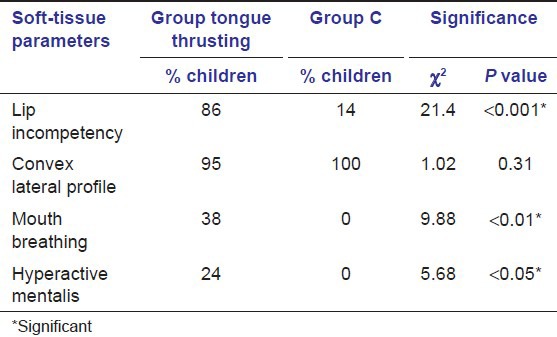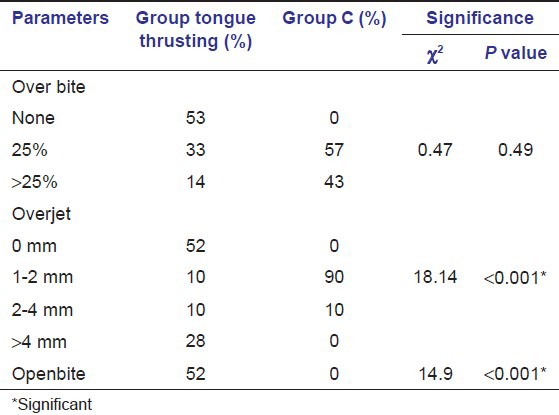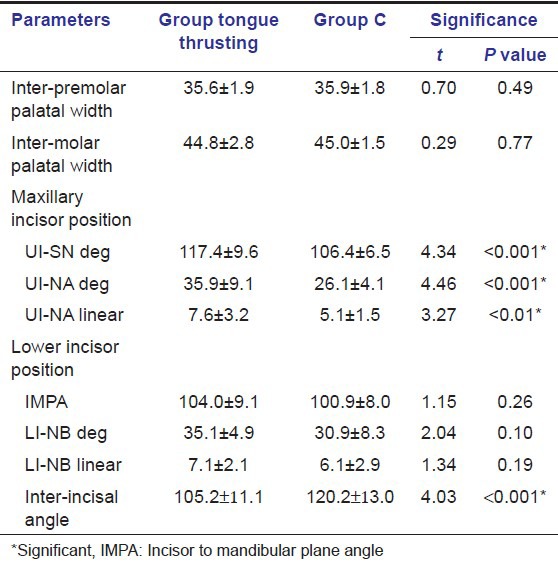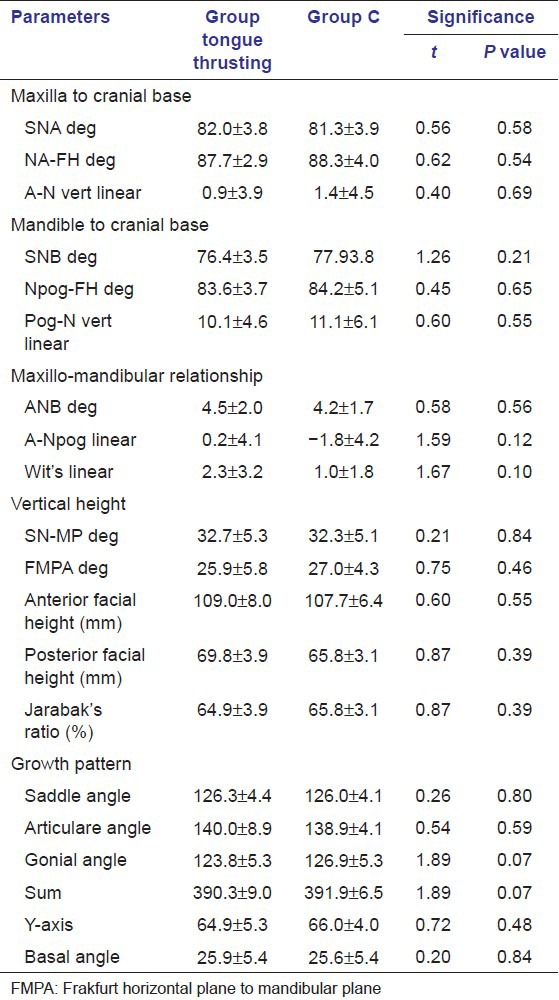Abstract
Background:
Tongue thrusting habit is a condition in which the tongue makes contact with any teeth anterior to the molars during swallowing. Abnormal positioning of tongue may result in dental and skeletal abnormalities.
Objective:
The aim of the present study was to study and compare soft-tissue, dental, and skeletal morphologic characteristics in children with and without tongue thrusting habit.
Materials and Methods:
A total of 21 children with tongue thrusting habit and 21 children without any habit between age 10 and 14 years were selected for the study. Various soft-issue, dental and cephalometric parameters were measured and compared statistically.
Results:
Significantly, higher number of children with tongue thrusting showed lip incompetency (86% vs. 14%), mouth-breathing habit (38% vs. none), hyperactive mentalis muscle activity (24% vs. none), Open-bite (52% vs. none) and lisping (86% vs. none) when compared to children without tongue thrust. Children with tongue thrust showed increased upper lip thickness and proclination of maxillary incisors No differences were found in angulation of mandibular incisors, inter-premolar or inter-molar widths and all the skeletal parameters studied.
Conclusions:
Tongue thrust seemed to affect some of the soft-tissue and dental characteristics causing lip incompetency, mouth-breathing habit, and hyperactive mentalis muscle activity, lisping, open-bite, and proclination of maxillary incisors; however, no significant skeletal changes were observed.
Keywords: Growth and development, occlusion/orthodontics, oral habits
Introduction
Tongue plays an important role in respiration, mastication, deglutition, and speech. In normal deglutition, the tip of the tongue rests on the lingual part of the maxillary anterior dentoalveolar area; the teeth come in momentary contact and there is minimal contraction of the perioral muscles, is minimal during deglutition, during swallowing, and there is neither a tongue thrust nor a constant forward posture. Tongue thrusting is a predominant swallowing pattern in infants. By age 2-4 years, functionally mature swallow develops.
Tongue thrusting habit is a condition in which the tongue makes contact with any teeth anterior to the molars during swallowing.[1] Most frequent signs of tongue thrusting are said to be forward tongue posture and tongue thrusting during swallowing, contraction of the perioral muscles (hyperactive mentalis and orbicularis oris), excessive buccinator hyperactivity, and swallowing without the momentary tooth contact normally required.[2]
It has been reported that prevalence of tongue thrusting decreases with increasing age.[3] Various epidemiological studies have reported prevalence of tongue thrusting to be 40-80% in children between age 4 and 6 years,[1,4] and 3-25% for children between age 12 and 15 years.[3,4] Wide variation in the prevalence rates is due to the use of different definitions of tongue thrusting.
Prolonged tongue thrusting habit has been shown to be associated with open-bite; however, if the open bite is a cause or an effect is not well established. While it has been noted that anterior position of the tongue may result in open-bite,[5] other evidence suggests that tongue thrusting habit may be an effect of an open-bite that, in actuality, may facilitate an otherwise absent oral seal.[6] Tongue thrust with an open-bite has been shown to be associated with long facial pattern and proclination of upper anterior teeth.[7] Other associated features with tongue thrust have been high and/or narrow maxillary arch[8] and Class II div I malocclusion.[9] It also may lead to lisping or impaired speech;[10,11] however, many tongue thrust patients do not exhibit altered sibilant production.[9]
There are no conclusive reports regarding the skeletal changes that occur in children due to long standing tongue thrusting habit. A few studies that have evaluated and compared skeletal changes, are between children with and without open-bite[12,13] without specifically, relating the open-bite with tongue thrusting. Therefore, present study was undertaken with the following objectives:
To study and compare soft-tissue and dental characteristics in children with and without tongue thrusting habit.
To study and compare skeletal morphologic characteristics in children with and without tongue thrusting habit.
Materials and Methods
Source of data
Twenty one children with tongue thrusting habit and 21 children without any habit were selected from a total of 864 children between ages 8 and 14 years. Selection criteria included absence of previous orthodontic treatment, premature loss of primary teeth, trauma or surgery in the dentofacial region, any other oral habits like finger sucking or lip sucking and systemic diseases.
Methodology
A total of 864 school children between age 8 and 14 years from the city of Bagalkot in the State of Karnataka, India were screened for presence of tongue-thrusting habit. Each child was asked to sit comfortably in a chair. He/she was asked to swallow saliva first and then 10 ml of water. Position of the tongue during swallowing was evaluated by depressing the child's lower lip with the operator's thumbs and simultaneously feeling the masseter muscle activity with the index fingers. Child was diagnosed as a tongue thruster if he/she fulfilled any one of the following criteria established by Weiss and Van Houten:[14]
He/she thrusted his/her tongue against the upper central incisors or between the upper and lower central incisors during swallowing.
Swallowed with his/her teeth apart, and/or Had excessive lower lip activity during swallowing.
After the initial screening, 46 children were identified as having tongue thrusting habit and 818 children without one. All the parents and children were informed regarding the nature of the study. Twenty one children (10 males, 11 females) with tongue thrusting habit were selected on the basis of parental approval and were assigned to the Tongue Thrusting Group. Among children without the habit, 21 children (17 males, 4 females) were selected on the basis of parents’ willingness and were assigned to the Control Group. Informed consents were obtained from all the parents. The study was approved by the ethical committee of the P. M. N. M. Dental College and Hospital, where it was conducted.
Each child was subjected to thorough clinical examination. Upper and lower impressions were obtained with alginate for each child and casts were poured in dental stone. Lateral cephalogram was obtained for each child using standard equipment and technique.
Assessment of soft-tissue characteristics
Each child was examined extra-orally for competency of lips, lateral profile, presence or absence of mouth breathing and hyper-activity of mentalis muscle. Position of the tongue-tip during swallow was determined by coating the tip of the tongue with a disclosing solution with a painting brush and asking the child to swallow his own saliva. The area of the palate or the teeth, which was stained, was noted. Presence or absence of indentations on tongue was also recorded.
Parameters including, facial angle (FH to soft-tissue Nasion-soft-tissue Pogonion), nasolabial angle, H-line angle, upper and lower sulcus depth, upper lip thickness, and upper lip strain were measured from the lateral cephalograms.
Assessment of dental characteristics
Various parameters including, open bite, over jet, overbite, inter-pre-molar palatine width and inter-molar palatine width were measured from patients’ casts and recorded to evaluate the dental characteristics. From lateral cephalograms parameters such as upper incisor to Sella-Nasion (SN) angular, upper incisor to Nasion-point A (NA)-angular, upper incisor to NA-linear, lower incisor to mandibular plane angle (IMPA), lower incisor to Nasion-point B (NB)-angular, lower incisor to NB-linear, and inter-incisal angle between upper and lower incisors were measured and recorded.
Assessment of skeletal characteristics
Various cephalometric angular and linear measurements were performed on the cephalograms to evaluate skeletal characteristics. To evaluate, the relationship of maxilla to the cranial base Sella-Nasion to Nasion-Point A (SNA), Nasion to Point A (NA) to Frankfurt Horizontal plane (FH), and Point A to Nasion (A-N) vertical (linear) were measured and recorded. To evaluate relationship of mandible to the cranial base SNB, Nasion-Pogonion (NPog) to FH, and Pog-N Vertical (linear) were measured and recorded.
To evaluate relationship of maxilla to mandible Angle between Nasion-Point A and Nasion-Point B (ANB), A-NPog, and Wits (linear) were measured and recorded. To evaluate changes in the vertical height SN-MP, Frakfurt horizontal plane to mandibular plane (FMPA), Anterior facial height (mm), Posterior facial height (mm), Jarabak's ratio (%) were measured and recorded. To evaluate the growth pattern of the mandible, saddle angle, articulare angle, gonial angle, Y-axis and basal angle were measured and recorded.
Assessment of speech
Each child was asked to pronounce words with sibilants and presence or absence of lisping during speech was recorded.
Statistical analysis
Unpaired student's t-test and Mann-Whitney test were used to compare various cephalometric measurements between the two groups. The threshold for the statistical significance was set at P < 0.05.
Results
Mean age for the Group TT (N = 21) and the Group C (N = 21) were found to be 10.6 ± 0.9 years and 11.0 ± 1.0 years, respectively and this difference was not found to be significant. One calibrated examiner evaluated, measured and recorded all the dental, skeletal, soft-tissue, and speech parameters.
Soft tissue characteristics
Tables 1 and 2 present the comparisons in various soft tissue parameters between the two groups. Significantly higher number of children with tongue thrusting showed lip incompetency (86% vs. 14%), mouth-breathing habit (38% vs. none) and hyper-active mentalis muscle activity (24% vs. none) when compared to children without tongue thrust. Furthermore, upper lip in children with tongue thrusting habit was significantly thicker (14.9 mm) than in children without the habit (13.4 mm). Although, naso-labial angle for children in the Group TT was found to be more acute, the difference between the two groups was not significant. Most of the children included in our sample had convex profile irrespective of presence or absence of tongue thrust.
Table 1.
Comparison of soft-tissue parameters: Percent of children affected

Table 2.
Comparison of mean values of soft-tissue parameters between the groups

Dental characteristics
Open-bite was present in half of the children with tongue thrust whereas, none without tongue thrust had open-bite, the difference being significant [Table 3]. Comparatively more children with tongue thrust showed edge-to-edge bite of incisors (no over jet), while most without tongue thrust exhibited 1-2 mm over jet. The difference was found to be significant.
Table 3.
Comparison of dental parameters (percent children affected) between the groups

Significantly, more children with tongue thrust showed proclination of maxillary incisors in all the three angles measured [Table 4] as compared to children without tongue thrust. However, no significant differences were found in proclination of mandibular incisors between the two groups. Inter-incisal angle was found to be significantly lower in children with tongue thrust indicating proclination of maxillary incisors.
Table 4.
Comparison of dental parameters (mean values±SD) between the groups

No significant differences were found in inter-premolar or inter-molar palatal widths between the two groups.
Skeletal morphological characteristics
No statistical differences were found in any of the parameters studied to evaluate relationship of maxilla to cranial base, mandible to cranial base, maxilla to mandible, vertical height, and growth pattern of the mandible between the two groups [Table 5].
Table 5.
Comparison of skeletal parameters (mean±SD) between the groups

Lisping
Eighteen of the 21 children (86%) with tongue thrust showed presence of lisping, whereas, none of the children without tongue thrust had lisping. This difference was found to be statistically significant (χ2 = 31.5, P < 0.001).
Discussion
Tongue plays an important role in many oral functions including respiration, mastication, deglutition, and speech. Although, tongue thrust swallow is a prominent feature in infants, it decreases with age because of an improved muscular balance during swallowing and this self-correction is said to occur by the age 3-4 years. Hence, the children between age 8 and 14 years were selected in our study. We anticipated that the effects of tongue thrust would be more pronounced in this age group due to prolonged duration of the habit.
In our study, significantly higher number of children with tongue thrust showed incompetency of lips. Similar findings have been reported by Barber and Bonus[13] and Tulley.[15] However, if incompetent lips are a consequence of tongue thrusting or incompetency of lips leads to tongue thrusting is not clearly established.
We found that significantly higher number of children with tongue thrust habit exhibited mouth-breathing as compared to children without the habit. Although, such relationship has not been reported in the literature, it has been suggested that mouth breathing may encourage tongue thrusting.[16] Significantly, in our study, 3 children from the Control Group exhibited incompetent lips; however, none of them showed mouth breathing. This finding is contrary to the earlier reported finding that mouth breathing could be a cause of incompetent lips.[17]
Significant finding in our study was that almost 25% of the children with tongue thrust showed hyper-active mentalis muscle. However, Hanson et al.[1] reported from their study that mentalis muscle contractions were not related to presence of tongue thrusting in 5-year-old children.
Children with tongue thrust in our study showed increased upper lip thickness. However, there are no reports published on correlation of lip thickness in children with tongue thrusting habit.
In our study, 50% of the children with tongue thrust exhibited open-bite whereas, none of the children without tongue thrust exhibited open-bite. Our findings are concurrent with the findings of Straub.[17] He concluded from his study that tongue thrusting was the primary cause of open bite.
Our results indicated that tongue thrust affected only maxillary incisors by proclining them, but there was no effect on the mandibular incisors when compared to the controls in our sample. This finding is concurrent with the findings of Alexander and Sudha[18] who reported a significant increase in proclination of upper anterior teeth in tongue thrust individuals. Contrary to our findings, Barber and Bonus[13] found no significant differences in Upper incisors (UI) to SN and UI-NA measurements in children with or without tongue thrust (age: 7-12 years). Cayley et al.[7] compared the cephalometric data of children (9-12 years) with anterior open bite associated with tongue thrust with children without anterior open bite or tongue thrust. They reported no significant differences in U1-SN measurement across the groups.
A strong association between tongue thrust and constriction of maxilla has been reported in the literature[1,8,17] which has been attributed to abnormal position of the tongue at rest. However, such differences were not found in the sample that we studied.
Differences in proclination of lower incisors between the two groups in our study were not significant. This may be because most of the children even in the control group showed convex profile and higher than normal upper incisor to SN and upper incisor to NA as well as IMPA and lower incisor to NB angles indicative of a bimaxillary dento-alveolar protrusion. Proclination of mandibular incisors in the control group may have masked the differences in the two groups in proclination of mandibular teeth.
Similar findings were reported by Jalaly et al. where they studied the effect of tongue thrust swallowing on position of anterior teeth and concluded that over jet was significantly increased in tongue thrusting patients.[19]
Tongue thrust did not cause any skeletal changes in the children studied in our sample. No such comprehensive study has been published in the literature. Machado and Crespo[20] compared the vertical facial growth between children with normal swallow and children with atypical deglutition. They found that except for mandibular angle none of the angles studied showed any significant differences.
In our study, 86% of the children with tongue thrust exhibited lisping as compared to none without tongue thrust. Subtelny et al.[16] reported that incidence of lisping was twice as high among the tongue thrusters as it was among the non-thrusters. Similar positive association between anterior open-bite and/or tongue thrust and lisping has been reported recently by Sahad M de et al., in 2008.[11]
Conclusions
From our study we conclude that: Tongue thrust seemed to affect some of the soft-tissue and dental characteristics causing lip incompetency, mouth-breathing habit, hyper-active mentalis muscle activity, lisping, open-bite, and proclination of maxillary incisors.
Tongue thrust had no effect on lateral maxillary growth and effects on mandibular incisor position were minimal.
Tongue thrust did not cause significant skeletal changes in the maxilla and mandible.
Footnotes
Source of Support: Nil
Conflict of Interest: None declared
References
- 1.Hanson ML, Barnard LW, Case JL. Tongue-thrust in preschool children. Am J Orthod. 1969;56:60–9. doi: 10.1016/0002-9416(69)90259-0. [DOI] [PubMed] [Google Scholar]
- 2.Peng CL, Jost-Brinkmann PG, Yoshida N, Chou HH, Lin CT. Comparison of tongue functions between mature and tongue-thrust swallowing: An ultrasound investigation. Am J Orthod Dentofacial Orthop. 2004;125:562–70. doi: 10.1016/j.ajodo.2003.06.003. [DOI] [PubMed] [Google Scholar]
- 3.Gellin ME. Digital sucking and tongue thrusting in children. Dent Clin North Am. 1978;22:603–19. [PubMed] [Google Scholar]
- 4.Fletcher SG, Casteel RL, Bradley DP. Tongue-thrust swallow, speech articulation, and age. J Speech Hear Disord. 1961;26:201–8. doi: 10.1044/jshd.2603.201. [DOI] [PubMed] [Google Scholar]
- 5.Lowe AA, Johnston WD. Tongue and jaw muscle activity in response to mandibular rotations in a sample of normal and anterior open-bite subjects. Am J Orthod. 1979;76:565–76. doi: 10.1016/0002-9416(79)90260-4. [DOI] [PubMed] [Google Scholar]
- 6.Wallen TR. Vertically directed forces and malocclusion: A new approach. J Dent Res. 1974;53:1015–22. doi: 10.1177/00220345740530050101. [DOI] [PubMed] [Google Scholar]
- 7.Cayley AS, Tindall AP, Sampson WJ, Butcher AR. Electropalatographic and cephalometric assessment of tongue function in open bite and non-open bite subjects. Eur J Orthod. 2000;22:463–74. doi: 10.1093/ejo/22.5.463. [DOI] [PubMed] [Google Scholar]
- 8.Brauer JS, Holt TV. Tongue thrust classification. Angle Orthod. 1965;35:106–12. doi: 10.1043/0003-3219(1965)035<0106:TTC>2.0.CO;2. [DOI] [PubMed] [Google Scholar]
- 9.Subtelny JD. Examination of current philosophies associated with swallowing behavior. Am J Orthod. 1965;51:161–82. doi: 10.1016/0002-9416(65)90001-1. [DOI] [PubMed] [Google Scholar]
- 10.Khinda V, Grewal N. Relationship of tongue-thrust swallowing and anterior open bite with articulation disorders: A clinical study. J Indian Soc Pedod Prev Dent. 1999;17:33–9. [PubMed] [Google Scholar]
- 11.Sahad Mde G, Nahás AC, Scavone-Junior H, Jabur LB, Guedes-Pinto E. Vertical interincisal trespass assessment in children with speech disorders. Braz Oral Res. 2008;22:247–51. doi: 10.1590/s1806-83242008000300010. [DOI] [PubMed] [Google Scholar]
- 12.Tsang WM, Cheung LK, Samman N. Cephalometric parameters affecting severity of anterior open bite. Int J Oral Maxillofac Surg. 1997;26:321–6. doi: 10.1016/s0901-5027(97)80789-8. [DOI] [PubMed] [Google Scholar]
- 13.Barber TK, Bonus HW. Dental relationships in tongue-thrusting children as affected by circumoral myofunctional exercise. J Am Dent Assoc. 1975;90:979–88. doi: 10.14219/jada.archive.1975.0204. [DOI] [PubMed] [Google Scholar]
- 14.Weiss CE, Van Houten JT. A remedial program for tongue-thrust. Am J Orthod. 1972;62:499–506. doi: 10.1016/0002-9416(72)90025-5. [DOI] [PubMed] [Google Scholar]
- 15.Tulley WJ. A critical appraisal of tongue-thrusting. Am J Orthod. 1969;55:640–50. doi: 10.1016/0002-9416(69)90040-2. [DOI] [PubMed] [Google Scholar]
- 16.Subtelny JD, Mestre JC, Subtelny JD. Comparative study of normal defective articulation of/s/as related to malocclusion and deglutition. J Speech Hear Disord. 1964;29:269–85. doi: 10.1044/jshd.2903.269. [DOI] [PubMed] [Google Scholar]
- 17.Straub WJ. Malfunction of the tongue. Part 1. The abnormal swallowing habit: Its causes, effects and results in relation to orthodontic treatment and speech therapy. Am J Orthod. 1960;46:404–24. [Google Scholar]
- 18.Alexander S, Sudha P. Genioglossis muscle electrical activity and associated arch dimensional changes in simple tongue thrust swallow pattern. J Clin Pediatr Dent. 1997;21:213–22. [PubMed] [Google Scholar]
- 19.Jalaly T, Ahrari F, Amini F. Effect of tongue thrust swallowing on position of anterior teeth. J Dent Res Dent Clin Dent Prospects. 2009;3:73–7. doi: 10.5681/joddd.2009.019. [DOI] [PMC free article] [PubMed] [Google Scholar]
- 20.Machado AJ, Jr, Crespo AN. A lateral cephalometric x-ray study of selected vertical dimensions in children with atypical deglutition. Int J Orofacial Myology. 2010;36:17–26. [PubMed] [Google Scholar]


